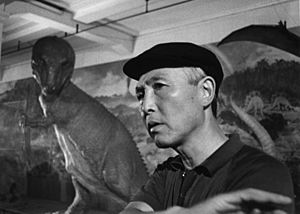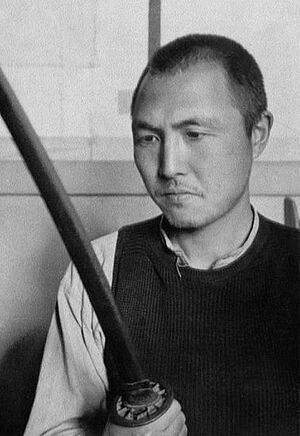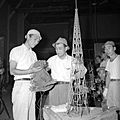Ishirō Honda facts for kids
Quick facts for kids
Ishirō Honda
|
|
|---|---|

Honda at the National Museum of Nature and
Science during the filming of Frankenstein Conquers the World. |
|
| Born | 7 May 1911 Asahi, Yamagata, Empire of Japan
|
| Died | 28 February 1993 (aged 81) Setagaya, Tokyo, Japan
|
| Resting place | Fuji Cemetery, Oyama, Shizuoka, Japan |
| Alma mater | Nihon University |
| Occupation |
|
| Years active | 1934–1992 |
| Known for |
|
| Spouse(s) |
Kimi Yamazaki
(m. 1939; |
| Children | 2 |
| Military career | |
| Allegiance | |
| Years of service | 1934–1946 |
| Rank | |
| Battles/wars | World War II (Second Sino-Japanese War) |
| Japanese name | |
| Kanji | 本多 猪四郎 |
| Hiragana | ほんだ いしろう |
| Romanization | Honda Ishirō |
| Signature | |
 |
|
Ishirō Honda (Japanese: 本多
Honda started in the Japanese film world in 1934. He worked as an assistant director for many years. His first movie as a director was a short documentary called Ise-Shima (1949). His first full-length movie, The Blue Pearl (1952), was a big hit in Japan.
In 1954, Honda directed and helped write Godzilla. This movie was a huge success in Japan. It led to the Godzilla series, which is the longest-running movie series ever. Godzilla also created the kaiju (giant monster) and tokusatsu (special effects film) genres. This made Honda famous worldwide. He directed many more tokusatsu films that people still watch and study today.
After directing his last Godzilla film in 1975, Honda stopped making movies. But his friend, director Akira Kurosawa, convinced him to come back. Honda then worked as Kurosawa's main helper for his last five films.
Ishirō Honda's Early Life and Career
Growing Up and Joining the Army (1911–1946)
Childhood and School Days

Ishirō Honda was born in Asahi, Yamagata, Japan, in 1911. He was the youngest of five children. His father was a Buddhist priest. Honda said his name meant "fourth son, born in the year of the boar." His older brother, Takamoto, was a military doctor. He encouraged Honda to study science, which made Honda love reading and science.
When Honda was ten, his family moved to Tokyo. He struggled with school subjects like chemistry and math there. Later, he studied kendo (a Japanese martial art) and swimming.
Discovering Movies
Honda became interested in movies when he was young. He would often sneak into theaters. In Japan, silent films had a "benshi," a narrator who spoke during the movie. Honda found these narrators more interesting than the films themselves.
His brother wanted him to be a dentist. But Honda chose to study film at Nihon University in 1931. The film program was new and sometimes disorganized. Honda used this time to watch many movies and take notes.
In 1933, Honda got an entry-level job at P.C.L. (later Toho Studios). He became an assistant director. His first job was on The Elderly Commoner's Life Study in 1934. Soon after, he was called to join the military.
Military Service and Family
Honda joined the Imperial Japanese Army in 1934 when he was 23. He served three times during World War II, for a total of six years. He was sent to China.
In 1937, he met Kimi Yamazaki, and they married in 1939. They had two children, Takako and Ryuji. During his time in the army, Honda was a sergeant. He was known for being respectful to the local people.
Near the end of the war, Honda was captured by the Chinese army. He was treated well and made friends with locals. He returned home to Japan in 1946. Even as an old man, he had nightmares about the war. He kept an unexploded bomb shell that landed near him during the war on his desk as a reminder.
Becoming a Director (1949–1975)
Back to Filmmaking
After the war, Honda returned to Toho Studios as an assistant director. He worked on many films. In 1949, he directed his first documentary, Ise-Shima. This film showed the cultural sights of the Ise-Shima region. It was special because it was the first Japanese film to successfully use underwater photography.
Honda also worked with his friend, the famous director Akira Kurosawa, on the film Stray Dog (1949). Honda directed many of the outdoor scenes, and Kurosawa was very happy with his work.
Directing His First Feature Films
Honda's first full-length movie was The Blue Pearl, released in 1951. It was one of the first Japanese films to use underwater shots. He also directed war films like Eagle of the Pacific (1953), which was a big hit. This was his first time working with Eiji Tsuburaya, who would become a famous special effects director.
The Birth of Godzilla
In 1954, a producer named Tomoyuki Tanaka wanted to make a giant monster movie. This idea came after a Japanese fishing boat was exposed to nuclear fallout from a nuclear test. Honda agreed to direct the film.
Honda and writer Takeo Murata spent three weeks writing the script for Godzilla. The story is about a huge monster that attacks Tokyo. It was a way to talk about the dangers of nuclear weapons.
Godzilla was a huge success in Japan. It won an award for its special effects. The movie started the Godzilla series, which is still popular today. It also made the kaiju (giant monster) and tokusatsu (special effects) movie styles famous.
More Monster Movies and Other Films
After Godzilla, Honda directed many other films. He made dramas and comedies, but he became most famous for his monster movies. In 1956, he directed Rodan, his first color film. It featured a giant winged monster.
In 1957, he directed The Mysterians, a science fiction film about an alien invasion. It had a very large budget and was filmed in a special wide-screen format called Toho Scope.
He continued to direct many popular monster films, including Mothra (1961), King Kong vs. Godzilla (1962), and Ghidorah, the Three-Headed Monster (1964). He also made other unique films like Matango (1963), about people turning into mushrooms.
Moving to Television
By the late 1960s, TV shows became more popular than movies in Japan. Honda started directing episodes for TV series in 1967. He directed episodes for popular shows like Return of Ultraman, Mirrorman, and Zone Fighter. He retired from filmmaking after directing Terror of Mechagodzilla in 1975.
Later Years and Legacy (1979–1993)
Working with Akira Kurosawa
After retiring, Honda was convinced by his good friend, the famous director Akira Kurosawa, to return to work. Honda helped Kurosawa on his last five films, starting with Kagemusha (1980). He worked as a special advisor and helped with directing.
Final Days
In late 1992, Honda started feeling unwell. He was diagnosed with a common cold, but his condition worsened. He was taken to a hospital. On February 28, 1993, Ishirō Honda passed away from breathing problems at the age of 81.
His funeral brought together many famous people from the film industry, including Akira Kurosawa and actor Toshiro Mifune. Honda's ashes were buried in Fuji Cemetery, a beautiful place known for its cherry blossoms.
Ishirō Honda's Directing Style
Ishirō Honda was known for being a very reliable director. Unlike some other directors who might go over budget or time, Honda almost always finished his movies on schedule and within budget. Even Godzilla was completed on time.
His assistant director, Kōji Kajita, said that Honda "never got mad, didn’t rush." He would quietly explain what he wanted and correct things. This skill earned him the nickname "Honda the Amylase," which refers to an enzyme that helps things break down smoothly.
Honda's films often showed everyday life, even during big monster attacks. For example, in scenes where people were running away, he would show firefighters and police officers doing their jobs. He felt it was important to show these normal parts of life even in extraordinary situations.
Influence and Impact
Ishirō Honda's work has had a huge impact on filmmakers around the world. He is seen as one of the creators of the modern disaster film. His movies set the standard for many big Hollywood blockbusters that came later.
Many famous directors have said Honda influenced them. Quentin Tarantino called him his "favorite science-fiction director." Directors like Guillermo del Toro and Tim Burton, and actor Brad Pitt, have said his film The War of the Gargantuas was an influence. John Carpenter called Honda "one of my personal cinematic gods," and Martin Scorsese also said Honda influenced his work.
Images for kids
See also
 In Spanish: Ishiro Honda para niños
In Spanish: Ishiro Honda para niños






